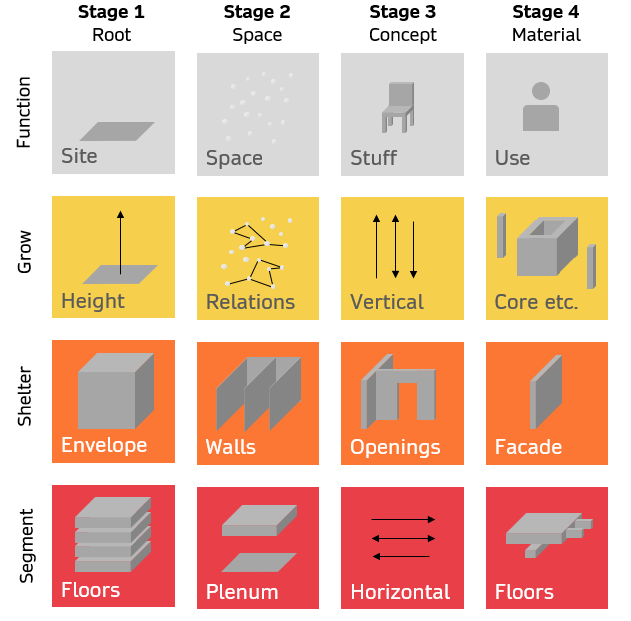DesignGrid
The DesignGrid has been developed over a number of years and we can now show it here. We are sharing it for inspriation, as whilst it works as an analytical framework, it does not currently help us to know how to grow a bulding or even a building system. Therefore this year we want you to tell us how you think this would happen. There are no right answers :)
Stage 1 (Root)
In this first stage the site, height and envelope and floors are defined.
S1A Site
The site is influenced by the location gene. This should also include the ‘set back’ on the site, that determines the maximum foot print of the building. Also need to consider site biodiversity and other factors.
S1B Height
The height is limited by the constraints of the project. This design grid is developed mainly for he use case of
S1C Envelope.
The envelope is the total external surface area of the building, although at this stage it is more of a bounding box. It is also not possible to know at this stage the transparency of the envelope until the requirements of the spaces are defined in stage 2.
S1D Floors
This is the first subdivision in the process. This horizontal subdivision is based on an assumption of the floor to ceiling height. As the design progress other factors will inform this such as the plenum depth defined in stage 2.
Stage 2 (Space)
Stage one creates an empty vessel subdivided by floors. In stage 2 spaces are poured into the box, ideally this should be done in a way that they are free to reorganise and find their place in the ‘building’.
S2A Space
At this stage the spaces are just floating points. They are the centre of what will later be a bounded zone.
S2B Relations
The relations define the promximal relationships of the spaces. For instance does a space need to be accessible from the ground floor or adjacent to another? Whilst this can be calculated in 3 dimensions it is also possible to ‘unwrap’ these relationships into a graph. If working in 3d each space node could be visualised with an attracting proximal sphere to help it make relations to other spaces.
S2C Bound
Having let the space nodes settle in the building and form linear relations to each other. It is now possible to explore the potential for spatial boundaries tangentially to the relational edges at their mid points. This creates the 2nd major subdivision of the building growth process.
S2D Plenum
The plenum results from the 3rd major subdivision in the building growth process. The Plenum is the ‘invisible’ space typically above a suspended ceiling that contains the horizontal building services beams and floor (slabs). Careful space planning of this area can have a massive difference of the overall height of the building and the ceiling height.
